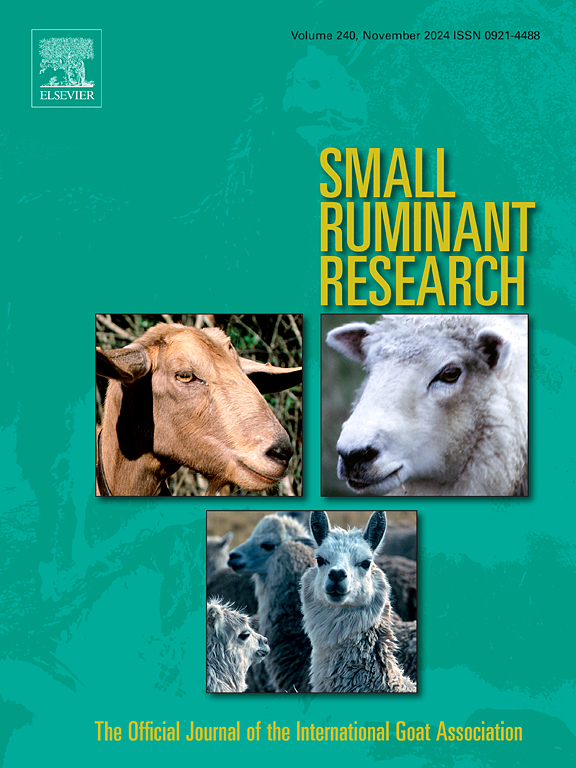Evaluation of acute phase proteins, hormonal changes and gene expression of immunological, metabolic and reproductive markers in she camel during the transition period
IF 1.6
3区 农林科学
Q2 AGRICULTURE, DAIRY & ANIMAL SCIENCE
引用次数: 0
Abstract
To explore gene expression and serum profile of acute phase proteins (APPs) and hormones during transition period in dromedary camels, blood samples were collected from twenty apparently healthy pregnant female at−21, 0, and+ 21 days of expected date of delivery. Toll like receptor 4 (TLR4), Beta defensin 5 (BDEF5), Toll like receptor 6 (TLR6), interlukin 2 (IL2), IL6 and IL8 markers showed down-regulation at 0 day, whereas an opposite trend was noted for Estrogen receptor (ESR) and Steroidogenic acute regulatory protein (StaR). A significant up-regulation of progesterone receptor (PR) and aromatase gene was also reported at −21 and + 21, respectively. A significant up-regulation of Iodothyronine Deiodinase 3 (DIO3) genes reported at −21 followed by 0 and + 21 days; however mRNA level of Acetyl CoA Carboxylase Alpha (ACACA) elicited an opposite trend. Our findings revealed a significant (p = 0.001) high values of haptoglobin (Hp) at 0 and + 21 day while the concentration of ceruloplasmin increased significantly (P = 0.001) at −21 day. Serum amyloid A (SAA), fibrinogen, cortisol and estrogen level increased significantly (P = 0.003) at 0 day then decreased at + 21 day. Serum level of progesterone decreased significantly (P = 0.001) at the 0 day, although serum concentration of T3 and T4 increased significantly (P = 0.001) at + 21 days. Significant changes in the levels of APPs, hormones may be a biomarker that aids in female camel health monitoring during the periparturient phase in order to reduce the frequency, severity of illnesses and, as a result, to establish selection-effective management strategy by studying the animal adaptation to harsh conditions through genetic selection which is strengthened by identifying differences in the expression levels of regulatory genes. These genes could be used to create adaptable animals that can reproduce in harsh environments without suffering large losses.
过渡期骆驼急性期蛋白、激素变化及免疫、代谢和生殖标志物基因表达的研究
为探讨单峰骆驼过渡时期急性期蛋白(APPs)和激素的基因表达和血清谱,分别在预产期- 21、0和+ 21天采集了20只健康孕妇的血液样本。Toll样受体4 (TLR4)、β防御素5 (BDEF5)、Toll样受体6 (TLR6)、白介素2 (IL2)、IL6和IL8标志物在0 d下调,而雌激素受体(ESR)和类固醇急性调节蛋白(StaR)则相反。孕激素受体(PR)和芳香化酶基因分别在- 21和+ 21位点显著上调。碘甲状腺原氨酸脱碘酶3 (Iodothyronine Deiodinase 3, DIO3)基因在- 21、0和+ 21天显著上调;而乙酰辅酶a羧化酶α (ACACA) mRNA水平则呈现相反的趋势。我们的研究结果显示,接触珠蛋白(Hp)在0和+ 21天显著(p = 0.001)高值,而铜蓝蛋白浓度在- 21天显著增加(p = 0.001)。血清淀粉样蛋白A (SAA)、纤维蛋白原、皮质醇和雌激素水平在0 d显著升高(P = 0.003),在+ 21 d显著降低。0 天血清孕酮水平显著降低(P = 0.001),+ 21天血清T3和T4浓度显著升高(P = 0.001)。app、激素水平的显著变化可能是一种生物标志物,有助于在围产期监测雌性骆驼的健康状况,以减少疾病的频率和严重程度,从而通过研究动物对恶劣条件的适应,通过识别调节基因的表达水平差异来加强遗传选择,从而建立选择有效的管理策略。这些基因可以用来创造适应性强的动物,这些动物可以在恶劣的环境中繁殖而不会遭受重大损失。
本文章由计算机程序翻译,如有差异,请以英文原文为准。
求助全文
约1分钟内获得全文
求助全文
来源期刊

Small Ruminant Research
农林科学-奶制品与动物科学
CiteScore
3.10
自引率
11.10%
发文量
210
审稿时长
12.5 weeks
期刊介绍:
Small Ruminant Research publishes original, basic and applied research articles, technical notes, and review articles on research relating to goats, sheep, deer, the New World camelids llama, alpaca, vicuna and guanaco, and the Old World camels.
Topics covered include nutrition, physiology, anatomy, genetics, microbiology, ethology, product technology, socio-economics, management, sustainability and environment, veterinary medicine and husbandry engineering.
 求助内容:
求助内容: 应助结果提醒方式:
应助结果提醒方式:


